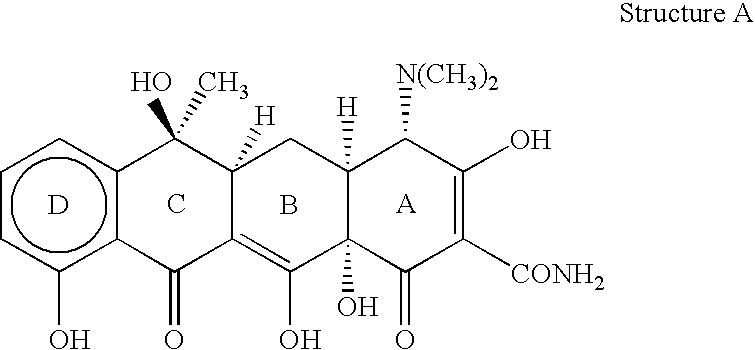Method for decreasing low density lipoprotein
lipoprotein technology, applied in the field of low density lipoprotein reduction, can solve the problems of affecting the normal blood circulation of patients, and forming atherosclerosis plaques, so as to c-reactive protein levels, and reduce the elevated serum/plasma low density lipoprotein-cholesterol levels
- Summary
- Abstract
- Description
- Claims
- Application Information
AI Technical Summary
Benefits of technology
Problems solved by technology
Method used
Image
Examples
example 1
Administration of Doxycycline at a Sub-Antibacterial Dose Decreases Plasma LDL-cholesterol
Acute coronary syndrome patients prescribed statins and still exhibited elevated cholesterol levels (total of 3 patients) were administered doxycycline at a sub-antibacterial dose (20 mg twice a day) for six months. After six months, the cholesterol fractions were then measured (Table 1). Table 1: The Effect of a 6-Month Regimen of Sub-Antibacterial Doxycycline on Cholesterol Values in Plasma of Acute Coromary Syndrome Patients with Elevated Baseline Cholesterol
Cholesterol Fractions (mg %)TotalLDL-HDL-HDL / CholesterolCholesterolCholesterolCholesterolBaseline Level231 ± 20155 ± 9 48 ± 170.216 Month Level190 ± 20107 ± 1248 ± 180.25Change Due to18%31%No Change19%TreatmentReductionReductionIncrease
After six-months of sub-antibacterial doxycycline treatment, total cholesterol was reduced by about 18%. The sub-antibacterial doxycycline reduced total plasma cholesterol to normal levels. A 19% increase ...
example 2
Lack of Correlation Between CRP Levels and LDL-Cholesterol Levels
Plasma of 30 patients who presented with acute coronary syndrome were analyzed, at baseline, for levels of high sensitivity CRP and total cholesterol, LDL-cholesterol, and HDL-cholesterol. No correlation was found between high sensitivity CRP and each of the following: total cholesterol, LDL-cholesterol, and HDL-cholesterol.
example 3
Administration of Doxycycline at a Sub-Antibacterial Dose Decreases LDL-cholesterol and CRP Levels in Diabetic Patients
Diabetic patients with elevated levels of cholesterol and CRP levels were administered 20 mg of doxycycline twice a day for at least two months. Doxycycline decreased LDL-cholesterol and improved the patients lipid profile. A decrease in CRP levels was also observed.
PUM
 Login to View More
Login to View More Abstract
Description
Claims
Application Information
 Login to View More
Login to View More - R&D
- Intellectual Property
- Life Sciences
- Materials
- Tech Scout
- Unparalleled Data Quality
- Higher Quality Content
- 60% Fewer Hallucinations
Browse by: Latest US Patents, China's latest patents, Technical Efficacy Thesaurus, Application Domain, Technology Topic, Popular Technical Reports.
© 2025 PatSnap. All rights reserved.Legal|Privacy policy|Modern Slavery Act Transparency Statement|Sitemap|About US| Contact US: help@patsnap.com


